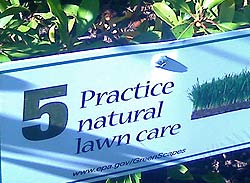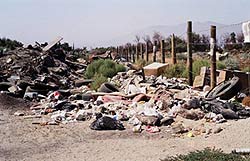About the author: Jeff Maurer manages Web content and does communications work for the Office of Solid Waste and Emergency Response. He has been with EPA since 2005.
A recent trip to the EPA GreenScaping exhibit at the US Botanic Garden (recently featured in a Green Scene video) revealed this: my dad owes me compensation for hundreds of lost hours during my childhood. By my calculations, I am owed no fewer than 220 child hours, the equivalent of two-and-a-half trips to Disney World or 73 afternoons at Chuckie Cheese. I have already let Dad know that I expect to collect on these damages promptly. Here’s my reasoning…
We had a large yard growing up, which needed to be mowed every Saturday. Because we lived in the South, that realistically meant that it needed to be mowed every Saturday morning, unless you wanted to risk heat stroke trying to shove our dreadnaught of a push-mower across the grounds. Mowing in the evening was out of the question, as allowing our lawn to remain unkempt through the afternoon would have caused my family to become the subject of public ridicule. Or so went my dad’s logic.
With fall came Sisyphean bouts of leaf-raking. The leaves, of course, needed to be raked so that the grass wouldn’t die. For some reason, it never occurred to Dad that if we abandoned the leaf-raking task, the lawn mowing task would become unnecessary as well, which seemed like a total win-win to me.
Periodically throughout the year, we would fertilize the lawn. The fertilizer was bright green – not so much “grass-colored” green, but more “spent-nuclear-waste” green. The fertilizer’s primary function was to clog the machine that applied it.
 These chores constituted a never-ending maintenance ritual that, though burdensome, I grudgingly acknowledged as necessary. And that is what I believed, until I saw this sign in our GreenScapes exhibit:
These chores constituted a never-ending maintenance ritual that, though burdensome, I grudgingly acknowledged as necessary. And that is what I believed, until I saw this sign in our GreenScapes exhibit:
I went to the natural lawn care page on our GreenScapes site, and it turns out that if you run a mulching mower over fallen leaves, it creates a natural compost that fertilizes your lawn! We could have combined these three chores into one! And there are more lawn care tips like that one that could have saved me countless hours of poorly-paid child labor! If I had known that a mulching mower was all that was standing between me and Saturday morning cartoons, I would have gladly used my allowance to subsidize an upgrade. A recent question of the week also revealed that many people have known about this for years. Unfortunately, my dad isn’t one of those people, which is why he now owes me several Saturdays worth of cheese pizza and ski-ball tickets.


 These chores constituted a never-ending maintenance ritual that, though burdensome, I grudgingly acknowledged as necessary. And that is what I believed, until I saw this sign in our GreenScapes exhibit:
These chores constituted a never-ending maintenance ritual that, though burdensome, I grudgingly acknowledged as necessary. And that is what I believed, until I saw this sign in our GreenScapes exhibit: The Torres Martinez Reservation in southern California has historically been a magnet for illegal dumping. With rapid development in the area, large migrant worker population, and commercial agricultural operations, the open land of the reservation was seen as an easy place to dump illegally. The problem became so bad that operators on the reservation started collecting money to accept waste on their property, creating environmental and human health hazards from ill-managed and exposed dumps, which often caught on fire. The business school concept of “maximize profit and minimize cost” needed to change to “maximize human health and minimize harm to the environment”.
The Torres Martinez Reservation in southern California has historically been a magnet for illegal dumping. With rapid development in the area, large migrant worker population, and commercial agricultural operations, the open land of the reservation was seen as an easy place to dump illegally. The problem became so bad that operators on the reservation started collecting money to accept waste on their property, creating environmental and human health hazards from ill-managed and exposed dumps, which often caught on fire. The business school concept of “maximize profit and minimize cost” needed to change to “maximize human health and minimize harm to the environment”.